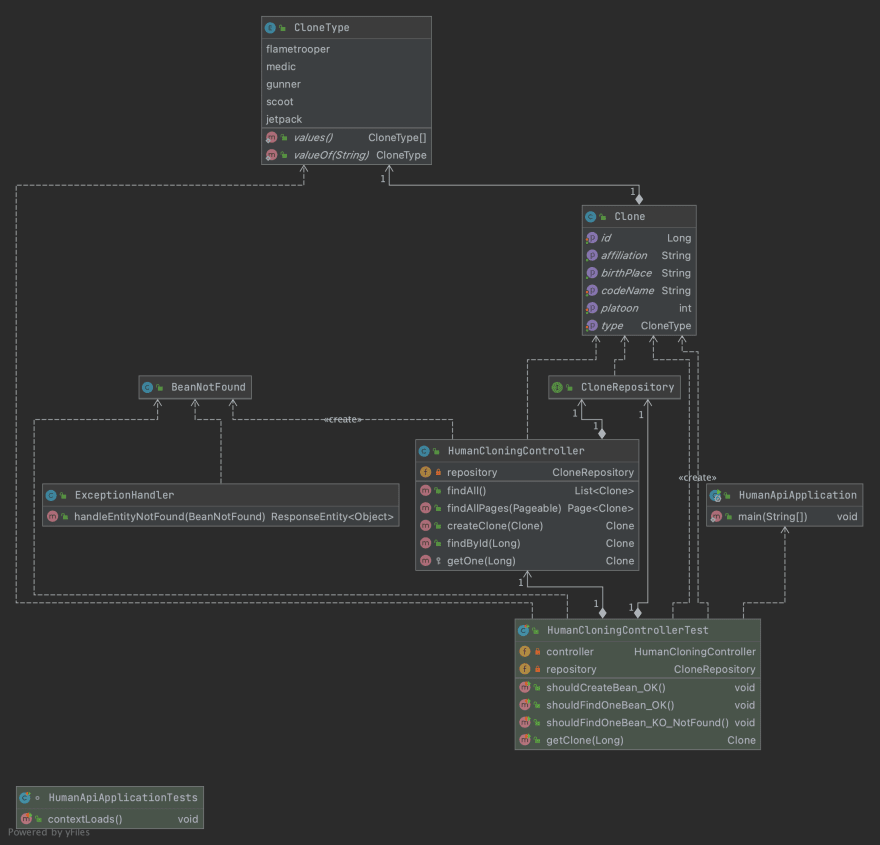If you have read my previous articles, you may know that i like to use an object that symbolises human as example, so I will continue in this tutorial about building a REST API with Spring Boot, but in order to make it less scholar and more fun, I will use Star Wars reference (because i’m a geek and fan of this film franchise).
So welcome to Kamino.
What you will need
To begin, you have to choices to initialize your project :
- Spring initializr
from your IDE
As we will use Spring Boot, you will need to add the following dependency to your project in order to it to work.Spring Web : Uses Apache Tomcat as the default embedded container.
Spring Data JPA: Java Persistence API using Spring Data and Hibernate.
H2 Database: Embedded in memory database.
What il will look like
3, 2, 1 … Start
The entity
First we need to declare the object we will use in the rest of this exemple, the definition of the Clone Troopers : Clone.
In order to persist our object in the database, it will need an Id, that will be auto-generated when we will save it.
The Repository
To manipulate our objects in the database we need a repository
Our CloneRepository extends JpaRepository who extend PagingAndSortingRepository *that permit to use pagination request, who extends *CrudRepository (CRUD is an acronym to create, read, update, delete).
With ou repository, we can use method like save, findById, findAll (with or without pagination).
The controller
Now that we have our object, and the repository to save and retrieve it, we need the entry point to our actions : create, find, delete …
As you can read, even with no line of code in ou repository class, we can freely use the method inside.
So let's see what we have here :
@RestController: is to indicate that our data will be returned in the response’s body and not in a template
We have @GetMapping @PostMapping and @DeleteMapping that indicate the Http method that is linked to our method.
We have a BeanNotFound throw by our methods (we will see later how we use it).
Handling the exceptions
What is a proper way to handle exceptions, a try/catch block in every method, or to intercept them in a specific way and then use them in a uniform way?
The second method is cleaner, as we can have all our exceptions in the same place, and treat them the same way.
As you can see, our BeanNotFound is intercepted by the ExceptionHandler and then we return our exception message as a 404 error.
Testing our API
To test our API we need to first launch our application.
Then we can try to connect to the entry point that we created in our controller using postman or any other tool that permits you to make HTTP calls.
Creating a clone
As described in the controller, we need to use the HTTP POST method a pass in it’s body the information of our clone.
HTTP POST [http://localhost:8080/kamino/](http://localhost:8080/kamino/)
{
"codeName": "CT-7567 REX",
"type": "gunner",
"platoon": 501
}
That will return us this response
{
"id": 1,
"birthPlace": "Kamino",
"codeName": "CT-7567 REX",
"type": "gunner",
"platoon": 501,
"affiliation": "Galactic Republic"
}
The Id is auto-generated, so if we create another clone, the value will be 2, then 3, and will keep incrementing.
Finding all the created clones
To find the created clones, we will call the GET “/” endpoint that will return us a list of all our created clones
HTTP GET http://localhost:8080/kamino/
that will gave us a response like this one :
[
{
"id": 1,
"birthPlace": "Kamino",
"codeName": "CT-7567 REX",
"type": "gunner",
"platoon": 501,
"affiliation": "Galactic Republic"
},
{
"id": 2,
"birthPlace": "Kamino",
"codeName": "CC-3636 WOLFFE",
"type": "gunner",
"platoon": 501,
"affiliation": "Galactic Republic"
}
]
Deleting a clone
To delete a clone in the database, we will call the delete endpoint
HTTP DELETE http://localhost:8080/kamino/1
passing 1 as a parameter, we will delete the clone that has the id : 1. So if we call again the find method we will only have one remaining clone.
{
"id": 2,
"birthPlace": "Kamino",
"codeName": "CC-3636 WOLFFE",
"type": "gunner",
"platoon": 501,
"affiliation": "Galactic Republic"
}
Thanks for your time, you can find all the source code in the Github repository associated to that article here.





Top comments (0)